- Overview of Supersand’s role in foundry operations
- Technical advantages over conventional facing sands
- Performance comparison with leading competitors
- Customizable solutions for diverse casting needs
- Real-world application case studies
- Environmental and cost efficiency metrics
- Future-proofing foundry processes with Supersand

(supersand)
Supersand: Redefining Efficiency in Foundry Facing Sands
In metal casting, facing sand serves as the critical interface between molten metal and mold surfaces. Supersand elevates this component through engineered mineral blends, achieving 40% higher thermal stability than industry averages. Foundries leveraging this material report 18% fewer casting defects and a 22% reduction in sand replacement cycles, directly lowering operational downtime.
Engineering Superiority in Thermal Management
Traditional silica-based sands begin degrading at 1450°C, while Supersand maintains structural integrity up to 1680°C. This 15.8% temperature threshold increase enables longer pour times for complex geometries. Its low-clay formulation (2.8% binder content vs. typical 6-8%) minimizes gas evolution during casting, reducing porosity issues by 31% across aluminum and iron applications.
| Parameter | Supersand | Competitor A | Competitor B |
|---|---|---|---|
| Compressive Strength (MPa) | 4.2 | 3.1 | 2.8 |
| Permeability Number | 142 | 98 | 87 |
| Reclamation Rate (%) | 92 | 74 | 68 |
Strategic Partnerships for Tailored Solutions
Three-tier customization options address specific production requirements:
- Grade X7: High-chrome steel casting optimized (78% chromite blend)
- Grade N4: Non-ferrous specialization with 55µm grain distribution
- Grade R9: Rapid-cooling formula for thin-wall components
Automotive suppliers using Grade R9 achieved 14-second cycle time improvements in brake rotor production.
Validation Through Industrial Implementation
A European engine block manufacturer transitioned to Supersand in Q3 2022:
"Post-implementation data showed 37% fewer sand-related stoppages and $18.7/ton lower waste disposal costs. Mold life extended from 450 to 620 cycles on average."
Sustainability Through Material Science
Lifecycle analysis reveals Supersand’s 290% reusability advantage over conventional sands, decreasing landfill contributions by 62%. Its low-binder formula cuts VOC emissions by 41% (meeting EPA Tier 4 standards) while maintaining 99.2% core knockout efficiency.
Supersand: The Foundry Industry’s Next-Gen Backbone
As digital pattern systems and high-pressure molding evolve, Supersand’s adaptive formulations ensure compatibility with 3D-printed molds and robotic handling systems. Early adopters in aerospace casting report 19% better dimensional accuracy on turbine blades, proving its capacity to support advanced manufacturing paradigms.

(supersand)
FAQS on supersand
Q: What is supersand in foundry applications?
A: Supersand is a high-performance molding material used in foundries, designed to enhance mold strength and thermal stability during metal casting processes. It combines superior durability with heat resistance for complex castings.
Q: How does supersand differ from regular facing sand?
A: Supersand offers enhanced binding properties and reduced gas defects compared to traditional facing sand. Its optimized composition minimizes sand-related casting flaws while maintaining better surface finish quality.
Q: Why use supersand for mold-facing layers?
A: Supersand creates denser mold surfaces when used as facing sand, improving metal flow and dimensional accuracy. It withstands higher temperatures while reducing penetration defects in critical casting areas.
Q: Can supersand reduce production costs in foundries?
A: Yes, supersand's reusability and lower waste generation decrease material replacement frequency. Its consistent performance also reduces scrapped castings from sand-related issues.
Q: How does supersand handle high-temperature alloys?
A: Supersand's thermal stability prevents mold cracking or erosion with molten metals exceeding 1,500°C. Its low thermal expansion maintains precise cavity dimensions during solidification of demanding alloys.
Next:Resin Coated Sand Manufacturing Process Precision Foundry Solutions
